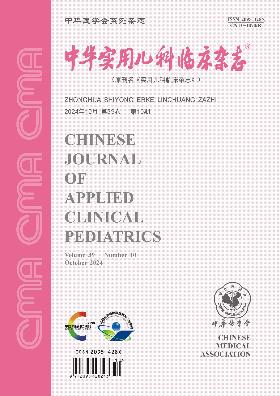Effect of 3 pediatric scores of critical illness in prognostic evaluation of children with sepsis in intensive care units
Q4 Medicine
引用次数: 0
Abstract
Objective To investigate the effect of 3 pediatric scores of critical illness including Pediatric Critical Illness Score (PCIS), Pediatric Logistic Organ Dysfunction Score 2 (PELOD-2), and Pediatric Multiple Organ Dysfunction Score (P-MODS) in estimating the prognosis of illness in children with sepsis in pediatric intensive care unit (PICU). Methods The data of 516 pediatric patients diagnosed as sepsis in PICU of Affiliated Hospital of Guangdong Medical University from June 2016 to June 2018 were retrospectively analyzed, and they were divided into survival group and death group according to the clinical outcome on the 28th day after admission.Then, the receiver operating characteristic (ROC) curve was plotted, and the efficiency of PCIS, PELOD-2 and P-MODS for predicting death was evaluated by the area under ROC curve (AUC). Results There were 488 pediatric patients survived, while 28 cases died during hospitalization.Compared with the survival group, the death group had a significantly lower PCIS score [86(82, 88) scores vs.89(84, 92)scores], and significantly higher PELOD-2 and P-MODS scores[PELOD-2: 6.5(4.0, 8.0) scores vs.0 (0, 2.0) scores, P-MODS: 3(2, 6) scores vs.1(1, 2) scores], and the differences were significant(Z=3 259.500, 14.228, 4.688, all P<0.05). ROC curve analysis showed that the AUCs of PCIS, PELOD-2 and P-MODS for predicting prognosis of pediatric patients with sepsis in PICU were 0.761, 0.916 and 0.761, respectively(Z=6.127, 14.228, 4.688, all P<0.05). Conclusions PCIS, PELOD-2 and P-MODS are effective and have good ability to assess the prognosis of pediatric patients with sepsis in the PICU.It seems that PELOD-2 is the most effective. Key words: Pediatric scores of critical illness; Pediatric intensive care unit; Sepsis; Prognostic evaluation重症监护病房脓毒症患儿3项危重症评分对预后评价的影响
目的探讨儿科危重症评分(PCIS)、儿科后勤器官功能障碍评分2(PELOD-2)和儿科多器官功能障碍评分(P-MODS)对儿科重症监护室(PICU)脓毒症患儿预后的影响。方法回顾性分析2016年6月至2018年6月在广东医科大学附属医院PICU诊断为败血症的516例儿科患者的资料,并根据入院后第28天的临床转归分为存活组和死亡组。然后,绘制受试者工作特性(ROC)曲线,并通过ROC曲线下面积(AUC)评估PCIS、PELOD-2和P-MODS预测死亡的效率。结果488例患儿存活,28例患儿在住院期间死亡。与存活组相比,死亡组的PCIS评分显著较低[86(82,88)分vs.89(84,92)分],PELOD-2和P-MODS评分显著较高[PELOD-2:6.5(4.0,8.0)分vs.0(0,2.0)分,P-MODS:3(2,6)分vs.1(1,2)分]。差异有统计学意义(Z=3259.500,14.228,4.688,均P<0.05)。ROC曲线分析显示,PELOD-2和P-MODS对PICU败血症患儿预后的预测值分别为0.761、0.916和0.761(Z=6.127、14.228、4.688,均P<0.05)。关键词:儿科危重症评分;儿科重症监护室;脓毒症;预后评估
本文章由计算机程序翻译,如有差异,请以英文原文为准。
求助全文
约1分钟内获得全文
求助全文
来源期刊

中华实用儿科临床杂志
Medicine-Pediatrics, Perinatology and Child Health
CiteScore
0.60
自引率
0.00%
发文量
14243
期刊介绍:
Chinese Journal of Applied Clinical Pediatrics ( semi-monthly ) is a core journal of paediatrics under the supervision of China Association for Science and Technology, sponsored by Chinese Medical Association and undertaken by Xinxiang Medical College. Founded in 1986, it is openly circulated both at home and abroad. The journal has several columns, such as Expert Forum, Experimental Research and Paediatric Surgery, which are mainly for paediatric medical workers and medical researchers in hospitals. Its purpose is to reflect the new theories and technologies in paediatric medicine and scientific research at home and abroad, and to promote academic exchanges.
Chinese Journal of Applied Clinical Pediatrics is a source journal of China Science Citation Database (CSCD), a core journal of Peking University, a source journal of Chinese science and technology paper statistics (China Science and Technology Core Journals), a core academic journal of RCCSE, a high-quality scientific and technical journal of China, a high-quality scientific and technical journal of China Association for Science and Technology, and a high-quality scientific and technical journal of China Biomedical Science and Technology Association. We have been published in China Biomedical Literature Database (SinoMed), China Knowledge Network, Wanfang Data Knowledge Service Platform, China Academic Journal Abstracts, Scopus Database, Chemical Abstracts (USA), Japan Science and Technology Agency (JSTA) Database, Copernicus Abstracts (Poland), Abstracts of the Centre for Agricultural and Biological Sciences (CABS) of the United Kingdom, Cambridge Scientific Abstracts ProQuest Database, WHO Medical Journal of the Western Pacific Region (WMPR), and WHO Medical Journal of the Western Pacific Region (WMPR) of the United States. We have been included in dozens of authoritative databases at home and abroad, such as WHO Western Pacific Region Index of Medicine (WPRIM), Ullrich's Guide to Periodicals, and so on.
 求助内容:
求助内容: 应助结果提醒方式:
应助结果提醒方式:


